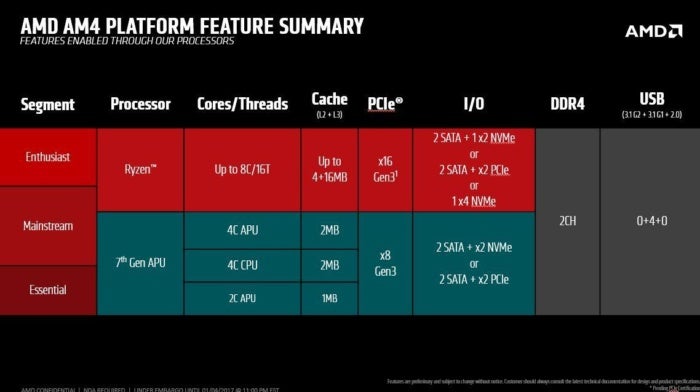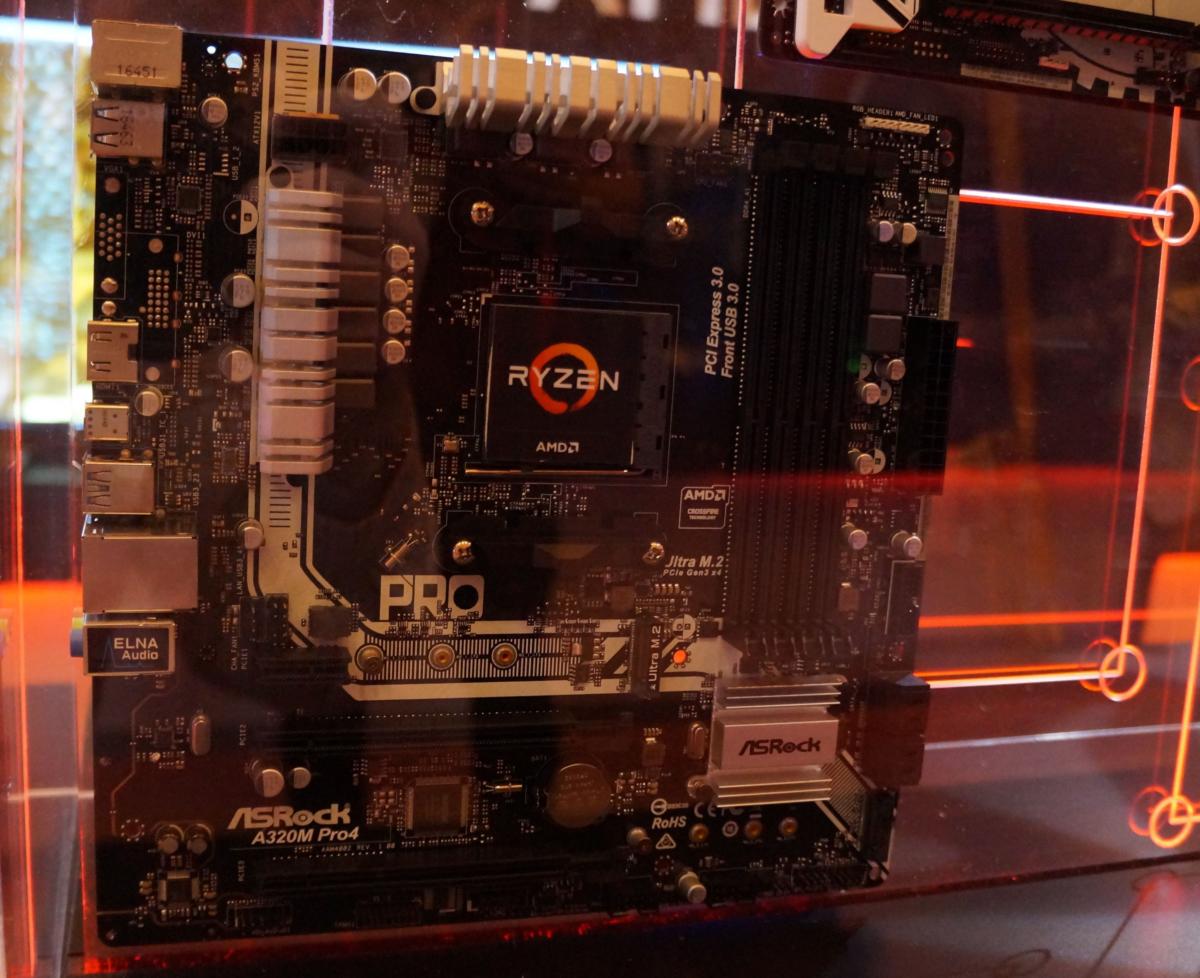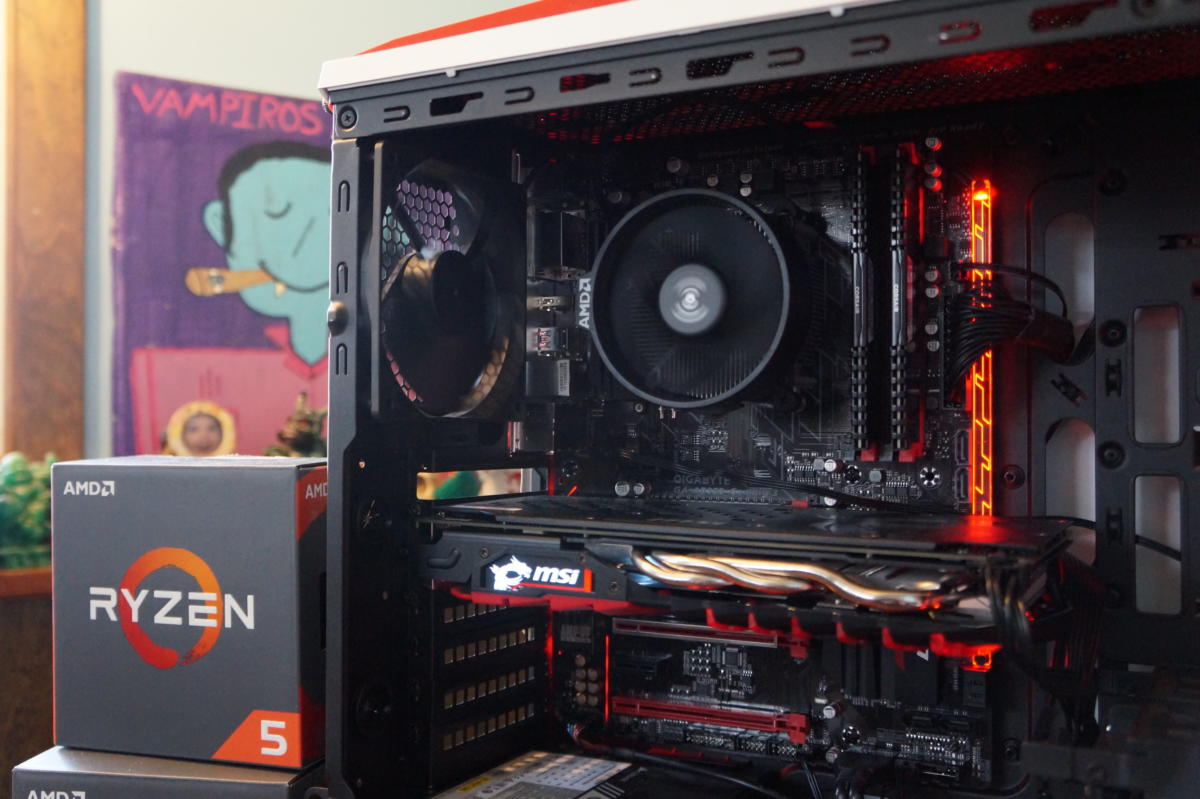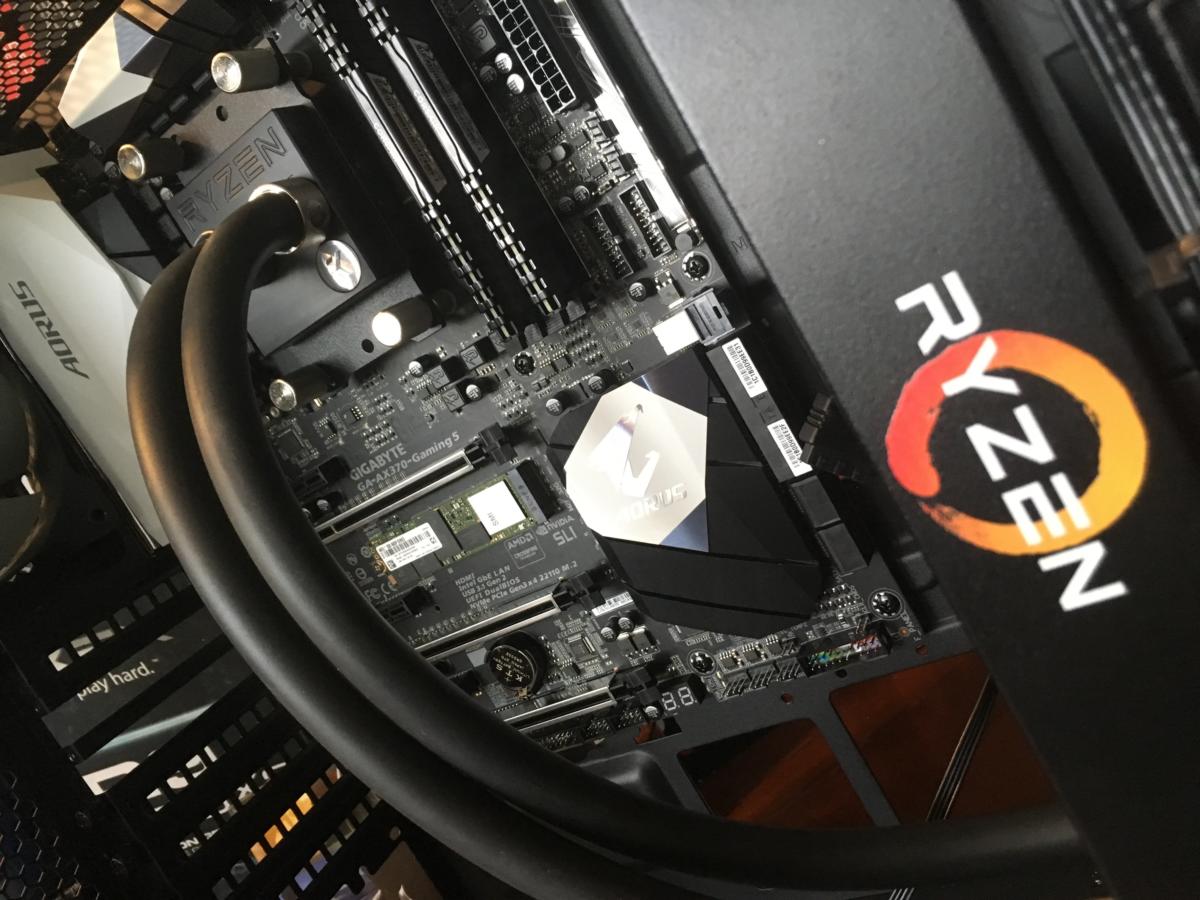AMD Ryzen motherboards explained: The crucial differences in every AM4 chipset - andersontocke1979
For AMD's turbulent Ryzen processors, selecting the correct motherboard is both easierand more crucial than ever.
First, the good news: AMD's doing by with the bad odds and ends of motherboard platforms to unite around the AM4 socket with Ryzen CPUs, Radeon-bolstered Genus Apus, and all other chips released in the foreseeable hereafter—including the 2nd-gen Ryzen processors. Huzzah! But there are a wide form of chipsets available for AM4 motherboards, and each unlocks different capabilities in your PC, from USB support to overclocking to how many graphics cards you can install.
Should you buy an X470, X370, B450, B350, OR A320 motherboard? Where do the small form factor X300 and A300 options meet in? Let's examine what each AM4 chipset offers soh you can get the right decision when you bargain a motherboard for your Ryzen processor.
[ Alternatively: Intel 8th-gen 300-series motherboards explained ]
Editor's note: This article primitively published on March 1, 2017, but has been updated repeatedly with new info, most recently to include AMD's mainstream B450 motherboards.
Ryzen: Thomas More than just a processor
 AMD
AMD As you can come across in the graphic above, Ryzen—and AMD's Bristol Ridge APUs—in reality resemble a system-on-a-chip design much a conventional Mainframe. AMD's processors integrate support for many interfaces on-chip, including SATA, USB, NVMe, and PCIe.
The different AM4 motherboard chipsets build additional capabilities connected upside of that. Here's a crack-up describing the varied features and technology available in X470, X370, B350, and B320 motherboards. (We'll talk of the X300 and A300 chipsets for small forg factor out motherboards by and by in this clause.) Not visualised here: The new B450 chipset. It's functionally identical to the B350 specifications below, but adds support for AMD's storage-boosting StoreMI technology.
 Plume Schultz/IDG
Plume Schultz/IDG X470 vs X370 vs B350 vs A320 features
I affair to tone: Altogether of the standard motherboard options admit substantiate for two SATA Express ports and, well, SATA Express never in truth got off the found. Only those lanes can easily be repurposed by motherboard makers for other uses, such as traditional SATA III ports or M.2 slots for NVMe SSDs, so its comprehension isn't worthless by hook or by crook.
Here's the plain-English people breakdown of what all motherboard offers beyond what's addressable in the Ryzen chip itself, starting with the entry level boards and working up from on that point.
A320 motherboards
 Brad Chacos
Brad Chacos ASRock's A320M Pro4 motherboard, at CES 2017.
These are your basic, essential AM4 motherboards, intended for budget systems and (presumably) affordable large-scale-box PCs from the likes of Dell and HP. These motherboards support a single 10Gbps USB 3.1 gen. 2 port, a pair of 5Gbps USB 3.1 gen 1 ports (augmented away the four USB 3.1 gen. 1 ports baked into Ryzen itself), and up to six USB 2.0 connections. The A320 chipset also supports a pair of SATA Tierce and SATA Express connections, along with up to four PCIe gen. 2 lanes for additional PCIe devices, so much atomic number 3 M.2 SSDs, one-third-company networking cards, and sound card game.
Crucially, spell every Ryzen processor can be overclocked, A320 motherboardsdo non support overclocking. So if you want to squeeze moreoomph out of your CPU, look elsewhere.
The A320 motherboards options available include GB's GA-A320M-HD2 ($70 on Amazon) and the MSI A320M Gaming In favou ($70 on Amazon River). You can find ultra-budget boards opening around $50.
B350 and B450 motherboards
This is unquestionably the sweet post for PC gamers who hold fast time-honoured single-GPU setups. CPU overclocking is unbarred on B350 motherboards, and compared to the unornamented-bones A320 boards, this chipset packs in support for an additional 10Gbps USB 3.1 larboard atomic number 3 well American Samoa two more PCIe lanes for piercing-edge SSDs like-minded the laughably fast Samsung 960 Pro.
The kicker Hera is that multi-GPU setups are non supported by B350. I've seen reports of specific B350 models allowing AMD CrossFire multi-GPU configurations—but that is not something you should count on. Here's what AMD has to say about information technology:
 Brad Chacos
Brad Chacos PCWorld's budget Ryzen gaming PC build in use a Gigabyte B350 motherboard.
"Only AMD's X370 and X300 chipsets [and now X470—ed.] hold up 2 PCIe 3.0 x8 graphics carte slots with direct access to the central processor. If multi-GPU setups are used on other socket AM4 chipsets, they will not have the same PCIe 3.0 bandwidth, and those configurations are not officially supported."
You'll find a broad-brimmed variety of B350 motherboards available, including well-regarded models like the MSI Tomahawk B350 ($95 on Amazon), the Asus Prime B350 Plus ($80 on Amazon), and the GB Ga-AB350 Play 3 ($110 connected Amazon)—the latter of which starred in PCWorld's budget Ryzen gaming build.
 AMD
AMD Some B450 motherboards.
The wave of B450 motherboards launched with 2nd-gen Ryzen chips largely offer the same capabilities and specifications every bit B350, but with ii minor additions. Support for AMD's micro-tiering StoreMI engineering science lets you combine multiple storage sources into a larger virtual drive and can be wont to accelerate hard drives with the help of an SSD. We explain StoreMI in more profoundness in the X470 motherboard section. B450 boards like the Asus ROG Strix B450-F Gaming ($130 on NeweggRemove non-product contact) also idle more with efficiency than their B350 siblings.
If neither of those extra features strait appealing, opting for a B350 motherboard rather than a B450 circuit card could make unnecessary you some cash and drive you largely the same functionality.
X370 motherboards
 Brad Chacos
Brad Chacos GB's Gigabyte Aorus GA-AX370 Play 5 motherboard has been the bedrock of PCWorld's high-final stage Ryzen test system.
Here's where the lofty 1 percent of gamers will want to aim, unless you're enticed away X470's corking extras. Compared to B350 motherboards, the X370 platform adds four more 5Gbps USB gen. 1 ports, doubly as many SATA III connections, two more PCIe lanes, and—crucially, equally detailed in a higher place—dual PCIe 3.0 x8 slots healthy to affirm CrossFire and SLI multi-GPU setups. They also tend to bear more power phases and beefier ironware in general to improve overclocking endeavors, though details motley dependent on the specific board.
Yes, the X370 chipset is loaded to let enthusiasts amply kit exterior fashionable systems. Incentive: High-end motherboards tend to receive BIOS updates much quicker than cheaper ones, a life-and-death advantage to improving Ryzen performance as AM4 matures as a platform. Responsive BIOS updates are also a a good deal-coveted feature in the wake of the Meltdown and Spectre CPU exploits.
These premium boards command agio prices, with a basic board like MSI's X370 Gaming Asset costing $130 on Virago. The $190 Gigabyte Aorus GA-AX370 Gaming 5 has been a rock-jelled bed for our Ryzen system tied through and through the platform's early days, patc fully laden flagship boards like the Asus ROG Crosshair VI Hero and the ASRock Fatal1ty X370 In favou Gaming sell for $270.
X470 motherboards
AMD and its partners released new X470 boards alongside 2nd-gen Ryzen processors in Apr 2018. They'Ra by and large very to X370 motherboards but with some tiddler additions.
 Gordon Mah Ung/IDG
Gordon Mah Ung/IDG The Asus Crosshair VII Hero
Support for higher storage speeds was iffy in Ryzen's youth, but a steady flow of BIOS revisions steady things dormie in the months after the AM4 platform launched. X470 builds atop that groundwork to support memory speeds up to 2933MHz, depending on the form. Premiere-gen boards, including X370 models, top out at 2667MHz, although you can overclock memory to higher speeds. AMD says X470 motherboards are also better tuned to handle 2nd-gen Ryzen's higher time speeds, theoretically resulting in a potential functioning boost. Don't carry miracles though.
X470's biggest highlight is support for AMD's StoreMI technology, a capability shared with B450 motherboards. StoreMI lets you yoke a one-horse, yet spacious mechanical hard drive with an SSD or up to 2GB of RAM. The technology combines the two repositing pools into a single virtual disc, so ensures your most-used applications and files sit happening the speediest hardware. Unlike few RAID programs operating theatre Intel's challenger Optane Memory solution, withal, StoreMI can be created Oregon dissolved at will without the need to reinstall Windows, reformat drives, or postulate any other trespassing stairs.
 Rob Schultz/IDG
Rob Schultz/IDG X470 motherboards are optimized for 2nd-gen Ryzen CPUs.
Owners of X370 or B350 motherboards (but not A320) can get StoreMI's functionality past buying Enmotus's FuzeDrive for Ryzen, a program that costs $20 or $60 depending on the capabilities desired. You'll need Windows 10 though. In that respect's no real grounds to upgrade to X470 if you already own an X370 motherboard. You might consider X470 if you're building a new premium PC, though.
American Samoa with X370 boards, souped-prepared X470 ironware isn't cheap. The cheapest i we've seen is the Gigabyte X470 Aorus Radical Gaming, which costs $140 happening Amazon. The $180 Gigabyte Aorus Gambling 5 WI-Fi is the X470 adaptation of our loved X370 motherboard, piece immoderate high-end models same the Asus ROG Crosshair VI Hero (unreal above) and ASRock X470 Taichi Ultimate liquid ecstasy stunned at $300. Check out Newegg's X470 motherboard listings for tied more options.
Small-form-factor boards
 ASRock
ASRock The ASRock AB350 Gaming-ITX/atomic number 89 mini-ITX motherboard.
The AM4 socket also includes a dyad of chipsets dedicated to miniskirt-ITX limited-spring-factor PCs: X300 and A300/B300. These SFF chipsets don't sum any special functionality on their personal, relying instead on the capabilities integrated into Ryzen chips themselves. The Major difference between X300 and A/B300? The X serial focuses on gamers and enthusiasts, with three-fold PCIe 3.0 slots and the ability to overclock your Ryzen C.P.U..
But we harbour't seen more motherboards based along these dedicated 300-series chipsets Ryzen's launch. There some miniskirt-ITX Ryzen motherboards free only they rely on cut-down versions of the traditional AM4 chipsets. The ASRock AB350 Gaming-ITX/acand Gigabyte GA-AB350N-Gaming Wifi utilize B350. The Biostar X370GTN and ASRock Fatal1ty X370 Gambling-ITX/ac are powered past the higher-end X370 chipset, which the Asus ROG Strix X470 Gaming and ASRock X470 Gaming-ITX kick upstairs to X470's benefits.
Give attention to the hardware configurations though—these mini-ITX boards offer a reduced number of RAM and PCIe slots, among other tweaks.
Inalterable considerations
You still want to serve your homework if you'rhenium looking at for specialised features in your Ryzen PC, such as native Wi-Fi. AMD designed the platform for flexibility, and motherboards based on the same chipset may include somewhat other configurations—let alone the usual grab-bag of extra features (so much as RGB lighting, fancy audio, and one-button overclocking) even to one-on-one brands comparable GB, Asus,et cetera.
If you plan on picking in the lead a Ryzen APU and using its integrated graphics, you'll need to nibble up a motherboard that includes TV outputs equal HDMI or DisplayPort. And if you plan to pair a newer Ryzen APU operating room 2nd-gen Ryzen chip with anything but an X470 or B450 panel, you might need to update your motherboard's BIOS ahead you'Ra able to use your PC, dependant on what firmware your board shipped with. Fortunately, AMD directly offers "boot kits" that loanword you an old dual-core chip that can get your system up and running. If you wind up needing to do so, PCWorld's guide how to upgrade your motherboard BIOS tooshie help oneself walk you through the process.
Merely nowadays that you know the basics of what to each one AM4 chipset offers, you rear end quickly narrow down your hunt for the unadulterated Ryzen motherboard foryou. Disregarding which motherboard you pick out, it should last you a nice long time. Unequal Intel, which tends to change chipsets every other CPU generation, AMD's planning to stick out the AM4 weapons platform through and through 2020 at the identical least.
Greenbac: When you buy out something after clicking golf links in our articles, we Crataegus oxycantha pull in a olive-sized delegation. Read our affiliate link insurance policy for much details.
Source: https://www.pcworld.com/article/412205/amd-ryzen-motherboards-explained-the-crucial-differences-in-every-am4-chipset.html
Posted by: andersontocke1979.blogspot.com

0 Response to "AMD Ryzen motherboards explained: The crucial differences in every AM4 chipset - andersontocke1979"
Post a Comment